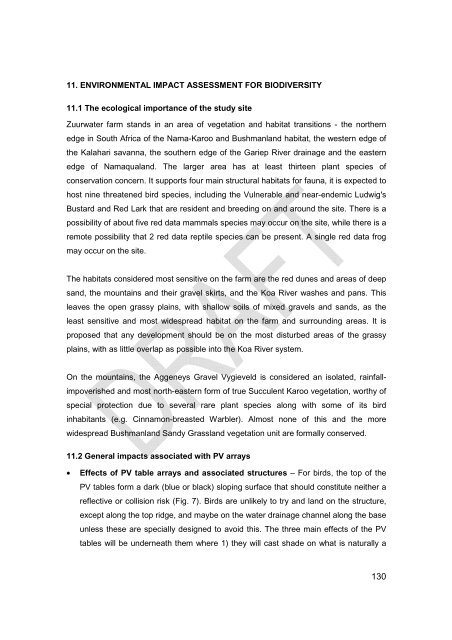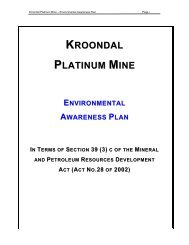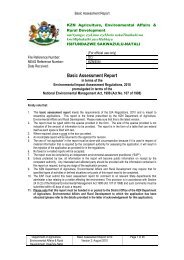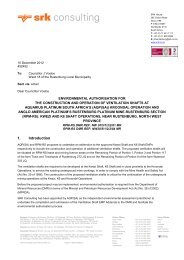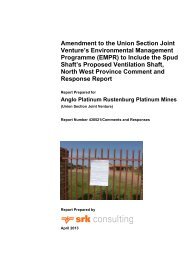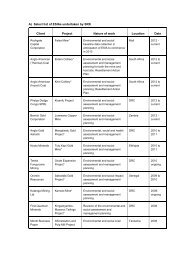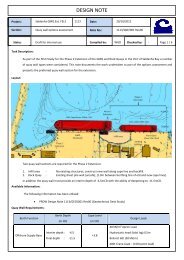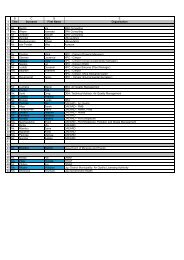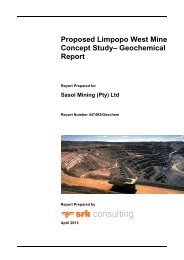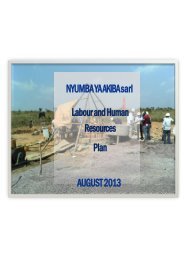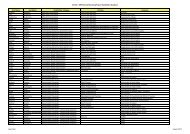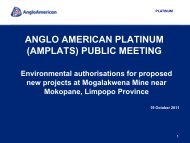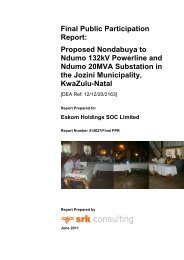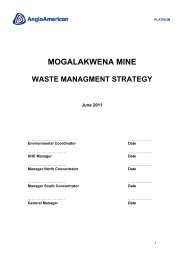Biodiversity (1 - SRK Consulting
Biodiversity (1 - SRK Consulting
Biodiversity (1 - SRK Consulting
You also want an ePaper? Increase the reach of your titles
YUMPU automatically turns print PDFs into web optimized ePapers that Google loves.
11. ENVIRONMENTAL IMPACT ASSESSMENT FOR BIODIVERSITY<br />
11.1 The ecological importance of the study site<br />
Zuurwater farm stands in an area of vegetation and habitat transitions - the northern<br />
edge in South Africa of the Nama-Karoo and Bushmanland habitat, the western edge of<br />
the Kalahari savanna, the southern edge of the Gariep River drainage and the eastern<br />
edge of Namaqualand. The larger area has at least thirteen plant species of<br />
conservation concern. It supports four main structural habitats for fauna, it is expected to<br />
host nine threatened bird species, including the Vulnerable and near-endemic Ludwig's<br />
Bustard and Red Lark that are resident and breeding on and around the site. There is a<br />
possibility of about five red data mammals species may occur on the site, while there is a<br />
remote possibility that 2 red data reptile species can be present. A single red data frog<br />
may occur on the site.<br />
The habitats considered most sensitive on the farm are the red dunes and areas of deep<br />
sand, the mountains and their gravel skirts, and the Koa River washes and pans. This<br />
leaves the open grassy plains, with shallow soils of mixed gravels and sands, as the<br />
least sensitive and most widespread habitat on the farm and surrounding areas. It is<br />
proposed that any development should be on the most disturbed areas of the grassy<br />
plains, with as little overlap as possible into the Koa River system.<br />
On the mountains, the Aggeneys Gravel Vygieveld is considered an isolated, rainfallimpoverished<br />
and most north-eastern form of true Succulent Karoo vegetation, worthy of<br />
special protection due to several rare plant species along with some of its bird<br />
inhabitants (e.g. Cinnamon-breasted Warbler). Almost none of this and the more<br />
widespread Bushmanland Sandy Grassland vegetation unit are formally conserved.<br />
11.2 General impacts associated with PV arrays<br />
• Effects of PV table arrays and associated structures – For birds, the top of the<br />
PV tables form a dark (blue or black) sloping surface that should constitute neither a<br />
reflective or collision risk (Fig. 7). Birds are unlikely to try and land on the structure,<br />
except along the top ridge, and maybe on the water drainage channel along the base<br />
unless these are specially designed to avoid this. The three main effects of the PV<br />
tables will be underneath them where 1) they will cast shade on what is naturally a<br />
130


